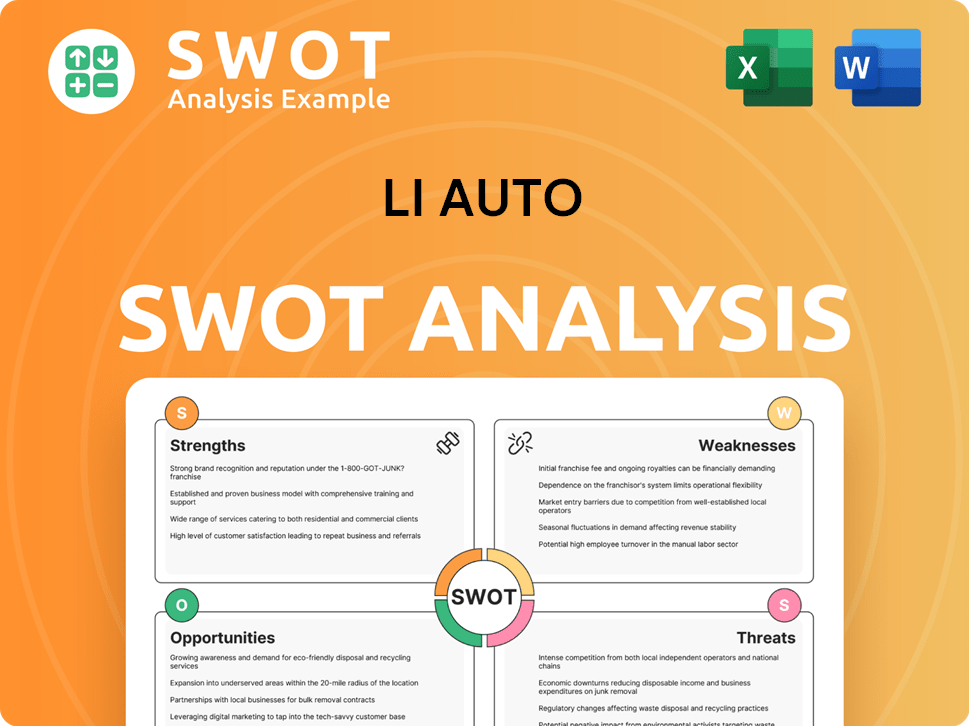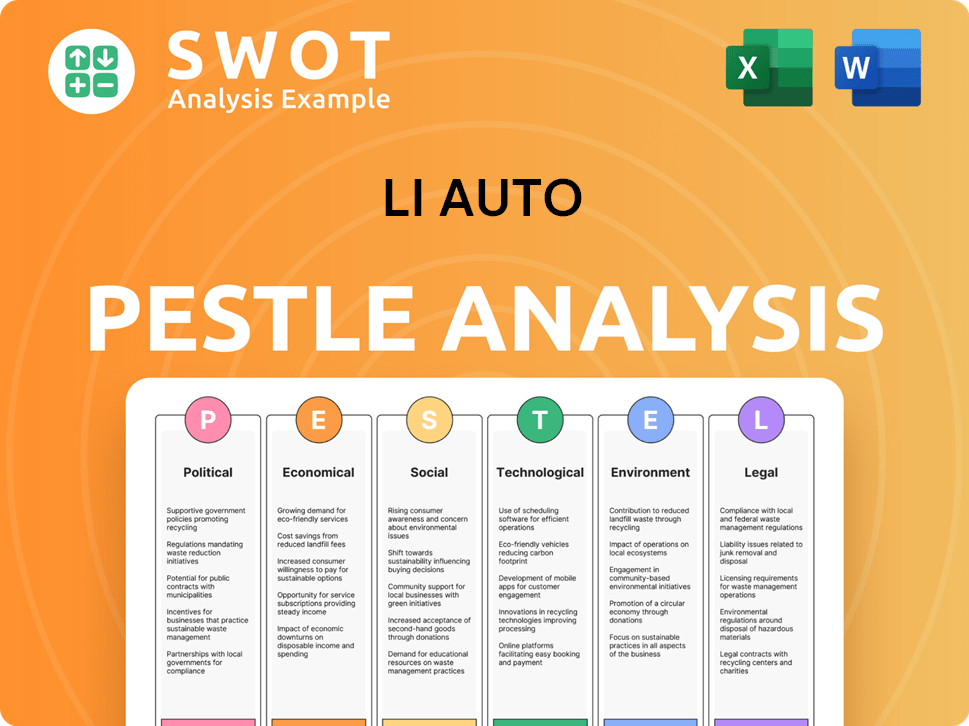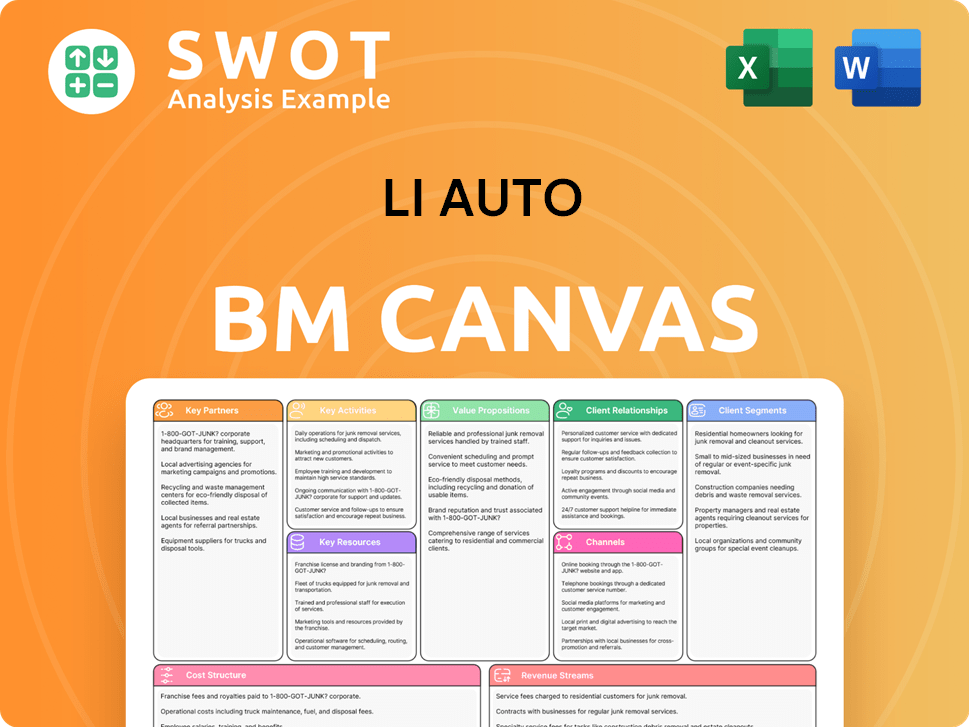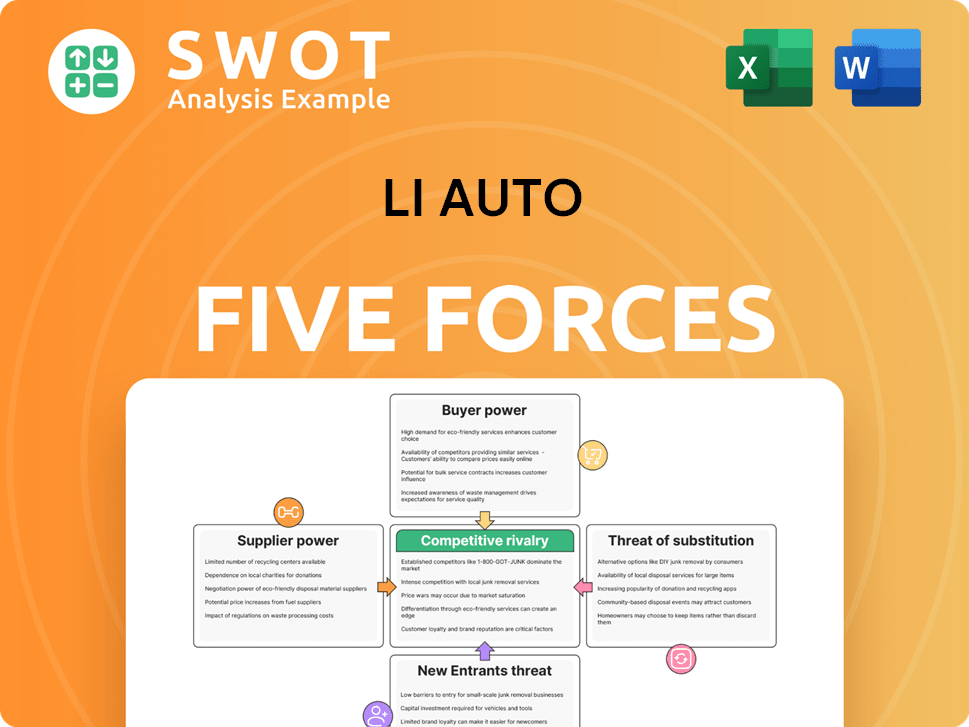Li Auto Bundle
How Does Li Auto Thrive in the EV Market?
Li Auto, a rising star in China's electric vehicle arena, has quickly become a major player, particularly in the premium segment. With a strategic focus on extended-range electric vehicles (EREVs) and a growing emphasis on battery electric vehicles (BEVs), Li Auto is capturing significant market share. In April 2025, the company demonstrated strong sales, delivering nearly 34,000 vehicles and solidifying its position as a sales leader.

This in-depth analysis will explore the inner workings of the Li Auto SWOT Analysis, examining its operational strategies, value proposition, and competitive advantages within the dynamic EV market. We'll dissect how Li Auto company generates revenue, its key strategic moves, and its future outlook, providing essential insights for investors and industry enthusiasts. Discover the secrets behind Li Auto's success, from its innovative Li Auto models to its cutting-edge Li Auto technology, and understand its position in the market.
What Are the Key Operations Driving Li Auto’s Success?
The core of the Li Auto company lies in designing, developing, manufacturing, and selling smart electric vehicles. Their primary focus is on extended-range electric vehicles (EREVs) and a growing range of battery electric vehicles (BEVs). The company targets the premium family SUV market, with the Li L series models being particularly successful. This strategic focus allows Li Auto to cater to the needs of families seeking both space and advanced technology in their vehicles.
Li Auto's operational processes are comprehensive, encompassing in-house technology development, manufacturing, supply chain management, sales channels, and customer service. A key aspect of their strategy is the in-house development of proprietary range extension systems, innovative electric vehicle technologies, and smart vehicle solutions. This vertical integration enables greater control over quality and innovation, which is crucial in the competitive EV market. By managing these aspects internally, Li Auto aims to deliver a superior product and customer experience.
The company's value proposition centers on providing premium, family-oriented electric vehicles that offer a blend of performance, technology, and convenience. Li Auto distinguishes itself through its EREV technology, which alleviates range anxiety, and by quickly adapting its product lineup to meet family user needs. The innovative seating in the Li MEGA Home is a prime example. Furthermore, Li Auto's focus on cost reduction and strategic pricing enhances its competitive edge, making their vehicles attractive to a broader audience.
Li Auto's manufacturing and supply chain are primarily based in China, fostering close collaborations with suppliers. The company has built a robust supply chain network, working closely with suppliers to source high-quality materials and components. Strategic partnerships with battery manufacturers ensure a stable supply of high-quality batteries. Furthermore, they partner with technology companies to integrate advanced features like autonomous driving capabilities and smart connectivity solutions into its vehicles.
Sales channels primarily involve a direct-to-consumer (DTC) model through a network of retail stores and service centers. As of May 31, 2025, Li Auto had 506 retail stores in 152 cities and 502 servicing centers in 222 cities across China. This extensive network, coupled with a robust supercharging infrastructure, enhances customer accessibility. This approach allows Li Auto to control the customer experience and build brand loyalty.
Li Auto emphasizes in-house development of key technologies, including range extension systems and smart vehicle solutions. They are committed to continuous innovation in electric vehicle technology. For instance, Li Auto partnered with o9 to enhance its end-to-end planning capabilities and build a resilient supply chain. Also, they established a joint innovation lab with Ianlon Technology in February 2025 to drive innovation in lightweight materials, structural design, and manufacturing processes for NEVs.
Li Auto has invested significantly in its charging infrastructure to support its growing customer base. As of May 31, 2025, the company had 2,414 supercharging stations equipped with 13,195 charging stalls. This investment is crucial for reducing range anxiety and improving the overall customer experience. This extensive network supports the company's commitment to providing a seamless ownership experience for Li Auto electric vehicles.
Li Auto’s success stems from its focus on the family market, its EREV technology, and its direct-to-consumer sales model. The company quickly iterates and expands its product lineup with features tailored to family needs. Furthermore, Li Auto's focus on cost reduction and strategic pricing has contributed to its competitive edge.
- Focus on family-oriented vehicles with advanced features.
- Innovative EREV technology to address range anxiety.
- Direct-to-consumer sales model for a controlled customer experience.
- Strategic partnerships for technology and supply chain resilience.
- Continuous investment in charging infrastructure.
For a deeper dive into the competitive landscape, including how Li Auto compares to its rivals, consider reading about the Competitors Landscape of Li Auto.
Li Auto SWOT Analysis
- Complete SWOT Breakdown
- Fully Customizable
- Editable in Excel & Word
- Professional Formatting
- Investor-Ready Format

How Does Li Auto Make Money?
The primary revenue stream for the Li Auto company is vehicle sales. This is supplemented by other services and sales, including charging solutions, software upgrades, and the sale of accessories.
In the first quarter of 2025, Li Auto reported total revenues of RMB25.9 billion (US$3.6 billion). Vehicle sales accounted for the majority, at RMB24.7 billion (US$3.4 billion). The company's financial performance reflects its focus on the electric vehicle market and related services.
For the full year 2024, Li Auto's total revenue was RMB144.5 billion (US$19.8 billion), with vehicle sales contributing RMB138.5 billion (US$19.0 billion). This demonstrates the company's strong position in the market and its ability to generate significant revenue from its core products.
Beyond vehicle sales, Li Auto generates revenue from other sales and services. This includes charging solutions, software upgrades, and the sale of accessories. The company is expanding its supercharging network to support these service-based revenue streams.
- In Q1 2025, total revenues reached RMB25.9 billion (US$3.6 billion), with vehicle sales at RMB24.7 billion (US$3.4 billion).
- For 2024, total revenue was RMB144.5 billion (US$19.8 billion), with vehicle sales at RMB138.5 billion (US$19.0 billion).
- Revenue from other sales and services in Q4 2024 was RMB1.6 billion (US$223.4 million), a 20.5% increase year-over-year.
- As of May 31, 2025, the company had 2,414 supercharging stations with 13,195 charging stalls.
Li Auto PESTLE Analysis
- Covers All 6 PESTLE Categories
- No Research Needed – Save Hours of Work
- Built by Experts, Trusted by Consultants
- Instant Download, Ready to Use
- 100% Editable, Fully Customizable

Which Strategic Decisions Have Shaped Li Auto’s Business Model?
Since commencing volume production in November 2019, the Li Auto company has achieved significant milestones. A key strategic move was the initial focus on extended-range electric vehicles (EREVs), such as the Li ONE, and later the Li L series (L6, L7, L8, L9). This approach helped address range anxiety, a major concern for EV buyers, and allowed the company to establish a strong market presence.
By the end of 2024, cumulative deliveries reached 1,133,872 vehicles, making it the first Chinese emerging new energy automotive brand to surpass one million cumulative deliveries. In April 2025, cumulative deliveries further increased to 1,260,675. The company has consistently been the sales champion for SUVs priced above RMB200,000 for three consecutive quarters, maintaining the highest market share in several large SUV segments.
The company has faced operational and market challenges, including intensifying competition in the EV market and a subdued market reception for some new launches, such as the refreshed L6. In response, the company has adopted a more cautious approach, lowering its 2025 sales goal to 640,000 vehicles from an earlier target of 700,000, with 520,000 units for its L-series EREVs and 120,000 for its pure electric lineup. Despite these adjustments, Li Auto is not planning large-scale layoffs and has implemented budget tightening measures.
Li Auto initially focused on EREVs to mitigate range anxiety. The company is now expanding into fully electric vehicles (BEVs) with models like the Li i8 (launching in July 2025) and Li i6 (scheduled for September 2025).
Li Auto has brand strength in the premium family SUV segment and technology leadership in EREVs and smart vehicle solutions. The company's resilient vehicle margin, which was 19.8% in Q1 2025, demonstrates its cost discipline.
The company is developing advanced driver-assistance systems (ADAS) technology, planning to launch the VLA Driver model with the Li i8. Li Auto continues to expand its charging infrastructure, aiming for 2,500 supercharging stations by June 2025 and 4,000 by year-end.
- Focus on EREVs to address range anxiety.
- Expansion into BEVs with new models.
- Development of advanced driver-assistance systems.
- Continued investment in charging infrastructure.
Li Auto Business Model Canvas
- Complete 9-Block Business Model Canvas
- Effortlessly Communicate Your Business Strategy
- Investor-Ready BMC Format
- 100% Editable and Customizable
- Clear and Structured Layout

How Is Li Auto Positioning Itself for Continued Success?
The Li Auto company has established a strong foothold in China's new energy vehicle (NEV) market, especially in the premium SUV segment. As of 2024, the company held a 4.5% market share in China's EV market, securing its position as the fourth-largest EV manufacturer. It continues to lead the SUV market for vehicles priced above RMB200,000.
Despite its market position, Li Auto faces various challenges. The Chinese EV market is highly competitive, with numerous domestic and international players vying for market share. Macroeconomic uncertainties, potential tariff hikes, and changing government policies on EV subsidies could also impact its operations and revenue. For in-depth information, consider exploring the perspective of Owners & Shareholders of Li Auto.
Li Auto is a key player in China's EV market, particularly in the premium SUV segment. Cumulative deliveries reached 1,260,675 units by April 30, 2025, showing significant customer adoption. The company's focus on SUVs priced above RMB200,000 has helped it maintain a leadership position.
The company faces intense competition in the Chinese EV market, which could affect its market share and pricing power. Macroeconomic factors, tariff hikes, and government policy changes pose additional risks. A decline in net profit in Q4 2024 and negative free cash flow of RMB2.5 billion (US$348.7 million) in Q1 2025 are also concerning.
Li Auto plans to expand its revenue through strategic initiatives and innovation. The company will launch the Li i8 BEV SUV in July 2025 and the Li i6 midsize BEV SUV in September 2025. It aims to deploy over 2,500 new supercharging stations by June 2025 and reach 4,000 by year-end.
While Q1 2025 saw a modest year-over-year revenue increase, there was a significant sequential decline from Q4 2024. Li Auto has lowered its 2025 sales target to 640,000 vehicles, but still projects a 28% increase from 2024 deliveries. The company is also advancing its ADAS technology, with the VLA Driver model set to launch with the Li i8.
Li Auto is focusing on expanding its product portfolio and charging infrastructure. This includes the launch of new BEV SUV models and the expansion of its supercharging network to support its growing customer base and vehicle sales.
- Launch of Li i8 and Li i6 BEV SUVs in 2025.
- Expansion of supercharging network to over 4,000 stations by the end of 2025.
- Advancement in ADAS technology with the VLA Driver model.
- Targeted sales of 640,000 vehicles in 2025, a 28% increase from 2024.
Li Auto Porter's Five Forces Analysis
- Covers All 5 Competitive Forces in Detail
- Structured for Consultants, Students, and Founders
- 100% Editable in Microsoft Word & Excel
- Instant Digital Download – Use Immediately
- Compatible with Mac & PC – Fully Unlocked

Related Blogs
- What are Mission Vision & Core Values of Li Auto Company?
- What is Competitive Landscape of Li Auto Company?
- What is Growth Strategy and Future Prospects of Li Auto Company?
- What is Sales and Marketing Strategy of Li Auto Company?
- What is Brief History of Li Auto Company?
- Who Owns Li Auto Company?
- What is Customer Demographics and Target Market of Li Auto Company?
Disclaimer
All information, articles, and product details provided on this website are for general informational and educational purposes only. We do not claim any ownership over, nor do we intend to infringe upon, any trademarks, copyrights, logos, brand names, or other intellectual property mentioned or depicted on this site. Such intellectual property remains the property of its respective owners, and any references here are made solely for identification or informational purposes, without implying any affiliation, endorsement, or partnership.
We make no representations or warranties, express or implied, regarding the accuracy, completeness, or suitability of any content or products presented. Nothing on this website should be construed as legal, tax, investment, financial, medical, or other professional advice. In addition, no part of this site—including articles or product references—constitutes a solicitation, recommendation, endorsement, advertisement, or offer to buy or sell any securities, franchises, or other financial instruments, particularly in jurisdictions where such activity would be unlawful.
All content is of a general nature and may not address the specific circumstances of any individual or entity. It is not a substitute for professional advice or services. Any actions you take based on the information provided here are strictly at your own risk. You accept full responsibility for any decisions or outcomes arising from your use of this website and agree to release us from any liability in connection with your use of, or reliance upon, the content or products found herein.